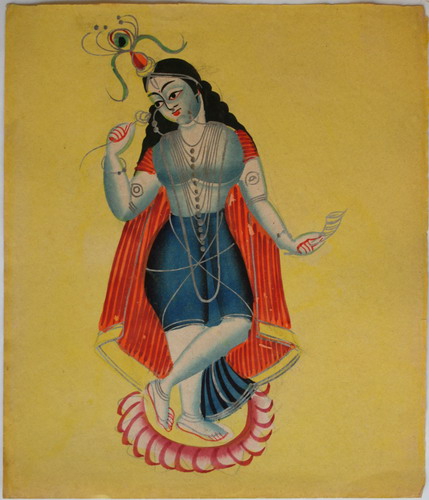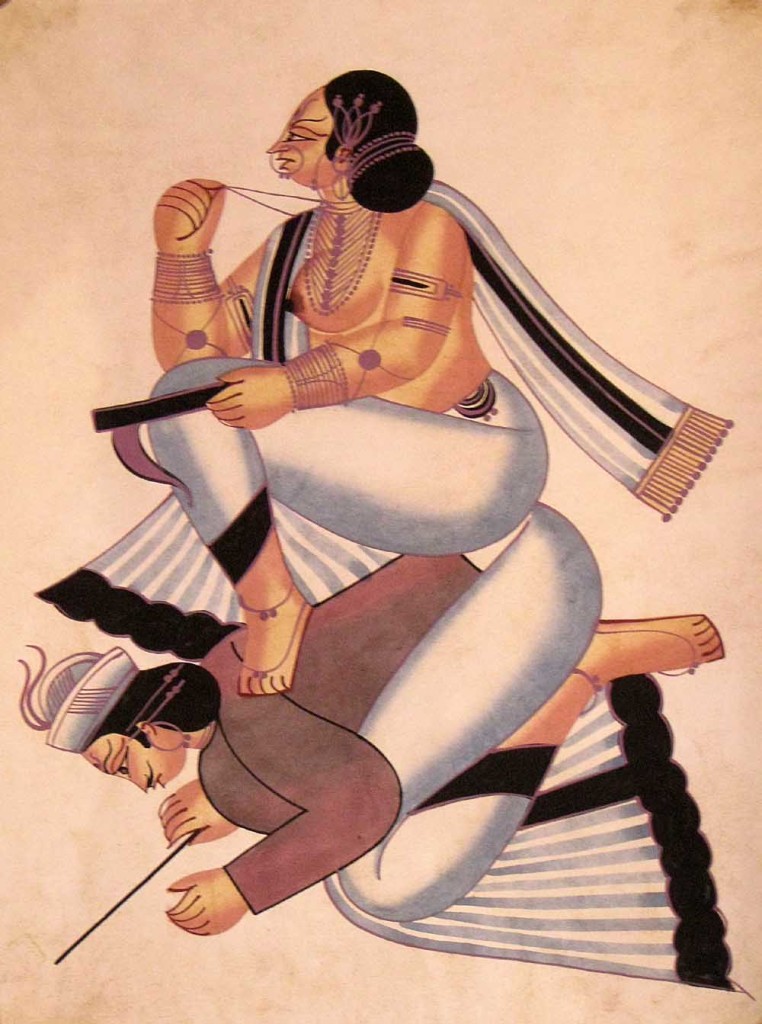![]()
Kalighat Paintings- Modern Art Inspired by Life in Kolkatta
Kalighat painting is a school of modern art that originated in 19th century Calcutta, India, which was then the capital of British India. Made on mostly cloth or paper scrolls, Kalighat paintings are so named due to the thriving settlement of the patuas or cloth-painters around the temples of Kali at Kalighat in Kolkatta. The theme of these paintings were mostly mythological characters that later evolved to civil life in Calcutta along with other secular and contemporary themes. The brushwork on these paintings are deemed by experts as deft, seamless, flowing and one of the smoothest art forms in India.
Background
The earliest form of art in Bengal was done on cloth or patas and even paper scrolls depicting scenes from Hindu religious epics like the Rama Charita Manas. In order to increase the customer base for their art form, the patuas moved to the urban center of Calcutta. Their move to settle around the temples, especially Kalighat Temple, was deliberate because this is where the themes of their art were most appreciated. Since Kalighat Temple was a popular religious destination, people would buy Kalighat paintings during their regular visits. During festivals, the painters would create paintings with a special theme, which was again very popular with the temple goers. The specific genre of Kalighat paintings is believed to have originated around 1850 in India.
One of the most famous art historians in India, Jyotindra Jain believes that there was no separate community of artists and artisans that were invested in the creation of the Kalighat paintings. These paintings, in fact, were made by artisans of different professions such as potters, stoneworkers, and carpenters.
Simultaneously, Calcutta was slowly undergoing changes in its education system under the British rule and had begun to recognize fine art as a mainstream field of study. This motivated artists to move to the city and learn newer techniques and appreciate modern themes, the influence of which can be seen in the later Kalighat paintings. Hence emerged two different styles of the Kalighat painting, the Oriental, and the Occidental, both of which were popular in the country.
Materials Used
Although it is obvious that there would have first been a sketch and an outline and eventually the filling of the motif, it is interesting to learn about the unconventional tools used to make these paintings. Squirrel and goat hair was used to make the brush that was used for sketch drawings. The black ink used for this purpose was made using soot produced by burning an oil lamp under a pot. The other vibrant colors used for filling the painting were essentially homemade in the form of either vegetable dyes or powdered stone fragments of different colors. The dry colors would be mixed with either gum or water to create paint fit to be used on paper and textile.
With the onset of industrial revolution in India however, the colors that were used were industrially produced along with the canvas.
The Making
Due to the era in which Kalighat paintings were born, they were created with natural dyes and on easily available materials such as cloth and scrolls. What is interesting about the Kalighat paintings is that an entire family would be involved in the creation of the piece. Each member of the family had a particular task in the creation process, based on sex and age. Economically, this translated as being one of the biggest cottage industries in West Bengal at the time.
- The women and children in the family are responsible for grinding the colors and creating the dyes. Other responsibilities included marking the outline in pencil and generally making all preparations for the painting.
- The first of the artists would copy only the outline of the sketch onto the canvas from the model sketch.
- A second artist would then draw and color the contours of the figures, as they were always human figures. The flesh would be depicted in a lighter shade than the muscles.
- The last among the artists would fill in the surrounding colors in the motif as well as the backdrop along with the final outline done in black.
Variety
The main distinguishing facet of the Kalighat paintings is the motifs used in them. Due to this, there are two types of Kalighat paintings that one can witness, Oriental and Occidental.
The Oriental Kalighat paintings depict gods, goddesses, mythological characters as well as scenes from religious Hindu texts. Some of the most popular motifs from this type include Rama-Sita, Radha-Krishna, goddess Durga, goddess Laksmi, goddess Annapurna, Hanuman, Shiva and Parvati, among others.
The other more contemporary style of Kalighat paintings are the Occidental variety that feature secular and civil themes like crime, women bathing, the evolving role of men and women in the society since the emphasis on women’s education, the hypocritical lives of the quasi-bourgeois, depictions of the freedom struggle, heroes of the struggle including Rani Lakshmi Bai and Tipu Sultan, a girl playing the sitar and other themes that common people could identify with. In this sense, Kalighat paintings were way ahead of their times and influenced a lot of critical thinking in those that appreciated this art form.
Besides motifs, Kalighat paintings feature the use of basic colors like indigo, blue, black, yellow, red and green due to the predominant use of homemade dyes. Only for ornamentation would artisans use silver and gold.
Present Day Scenario and Global Influence
Kalighat paintings are now on exhibit across the globe, right from Britain to Prague to Philadelphia. It is one of the most well-recognized forms of Indian modern art that has been witnessed globally. Besides being an art form, it is also used as a modern motif in the creation of fashionable ethnic Indian garments. Indian designers have been inspired by this genre of art to create some of the most unusual motifs to have ever been spotted on a saree. This, however, has played a great role in widening the scope of its reception and bringing it to younger people whose interest lies more in unique fashion than in modern art forms.
Innovations
Kalighat paintings also saw a diversification in the motifs or subjects for their paintings. Pets and other animals such as cats, fish, lobsters, prawns, birds etc. were also used as primary subjects in a string of Kalighat paintings. Experts say, that this shift in theme could have been influenced either by the Mughal fascination with fauna or with British, and by extension Western, interest in modern themes.
Facts and Trivia
- Kalighat paintings have said to influence modern artists like the late Jamini Roy.
- The largest collection of Kalighat paintings is not in India, but rather in the Victoria & Albert Museum in London.
- The earliest Kalighat paintings were made on long scrolls and the artisans would sing songs related to the theme of the painting in order to sell them.
- The customer base for the Kalighat paintings increased and expanded to include traders and merchants from the Western parts of the country, in the 19th century.
- Many Western art scholars have studied the Kalighat paintings and made an effort to interpret them. However, many of them got the plots wrong and the misconceptions were dismissed only about two decades ago.
References
- http://en.wikipedia.org/wiki/Kalighat_painting
- http://ngmaindia.gov.in/sh-kali-painting.asp
- https://www.pinterest.com/dollsofindia/bengal-folk-paintings-also-called-kalighat-paintin/
- http://www.penn.museum/documents/publications/expedition/PDFs/42-3/Kalighat.pdf
- http://www.india-crafts.com/kalighat-painting.html
Categories: Motifs & Embroideries


